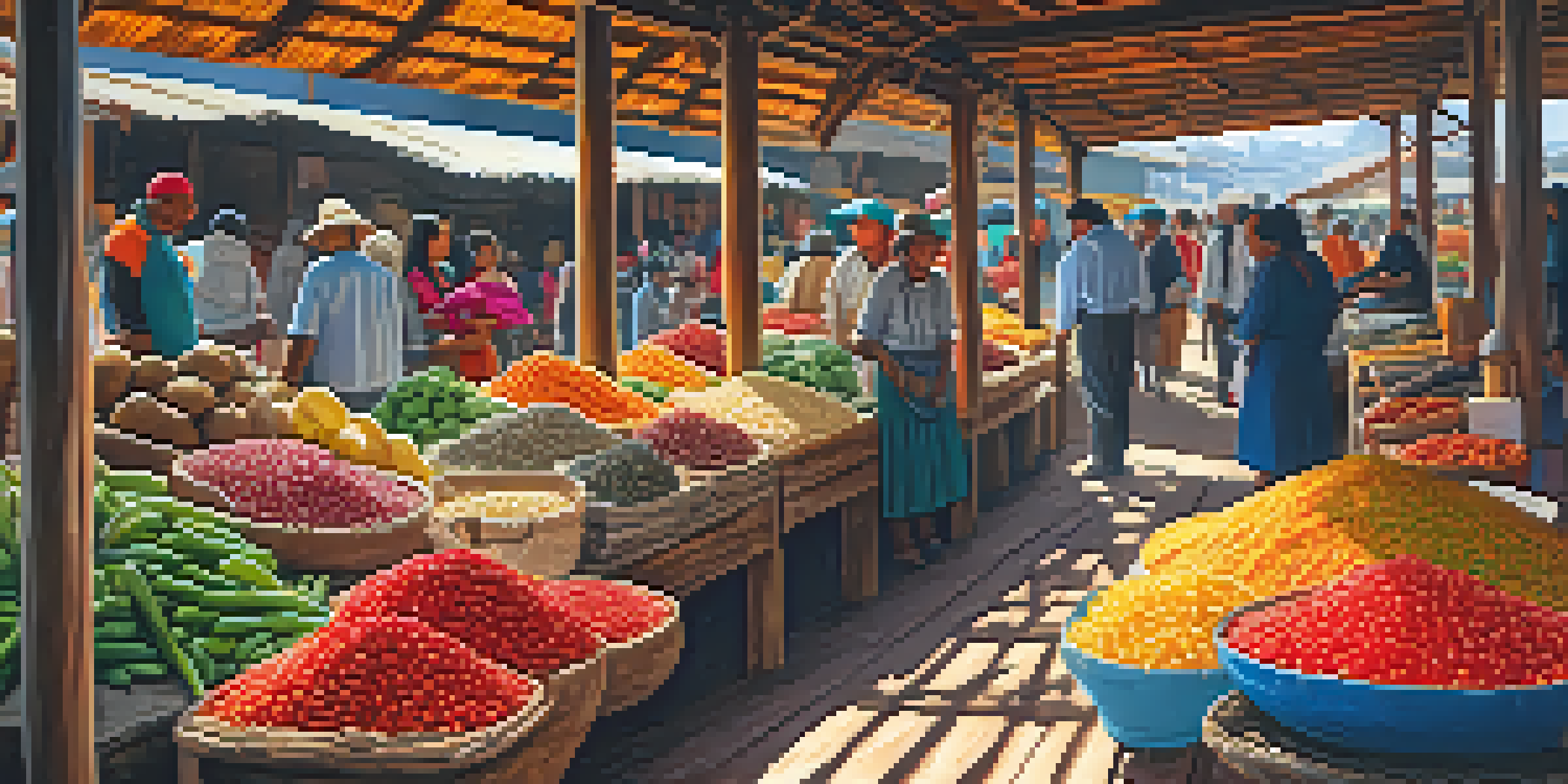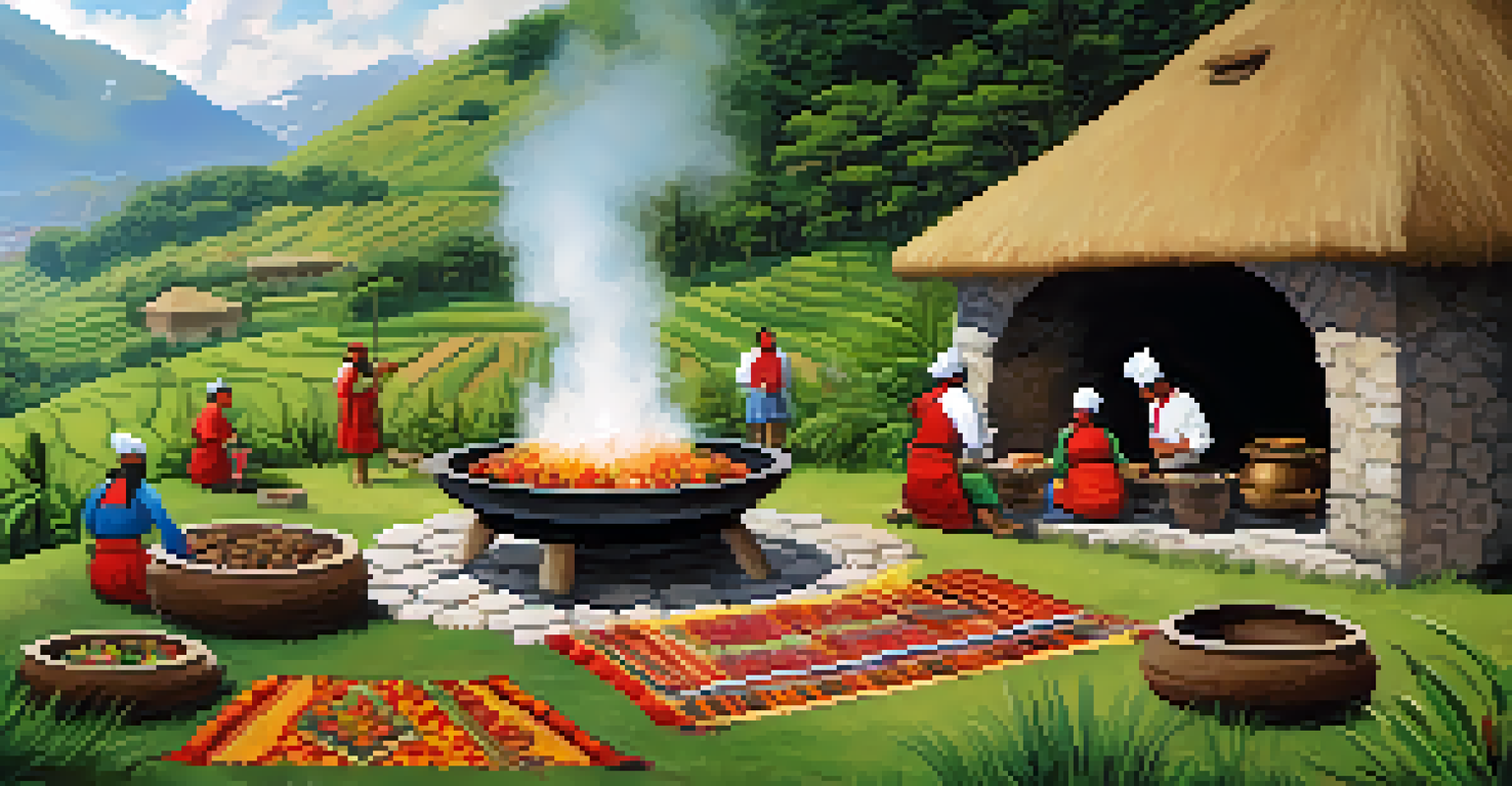Fusion of Cultures: The Evolution of Peruvian Culinary Identity

The Historical Roots of Peruvian Cuisine
Peruvian cuisine is a vibrant tapestry woven from various cultural influences. The history of this culinary identity dates back to ancient civilizations like the Incas, who cultivated diverse crops such as potatoes and corn. With the arrival of Spanish colonizers in the 16th century, new ingredients and cooking techniques were introduced, creating a unique fusion that laid the groundwork for modern Peruvian dishes.
The secret of good cooking is, first, having a good recipe, and second, having a good taste.
As immigrants from Asia, Africa, and Europe settled in Peru, they brought their culinary traditions, which further enriched the local cuisine. For instance, the Chinese introduced stir-frying techniques, while Italian immigrants popularized pasta. This blend of influences has resulted in a culinary landscape that is both diverse and dynamic, showcasing the adaptability of Peruvian food.
Today, Peru is celebrated as a gastronomic powerhouse, with chefs creatively blending traditional ingredients with global flavors. This evolution reflects not only the country's rich history but also its ongoing journey towards culinary innovation. By embracing its multifaceted past, Peru has crafted a distinctive culinary identity that continues to captivate food lovers around the world.
Key Ingredients that Define Peruvian Cuisine
At the heart of Peruvian cuisine are its key ingredients, many of which are native to the region. Potatoes, for example, come in thousands of varieties, each adding unique flavors and textures to dishes. Quinoa, another staple, is celebrated for its nutritional value and versatility, often featured in both traditional and modern recipes.

Seafood also plays a significant role in Peruvian cooking, particularly in coastal regions. The Pacific Ocean provides an abundance of fish and shellfish, which are essential for dishes like ceviche, a refreshing mix of raw fish marinated in citrus juices. This dish exemplifies the freshness and bold flavors that characterize Peruvian cuisine.
Peruvian Cuisine's Diverse Roots
Peruvian cuisine is a vibrant blend of indigenous, Spanish, and immigrant influences that has evolved into a unique culinary identity.
Additionally, the use of herbs and spices, such as cilantro, ají peppers, and garlic, brings depth and complexity to the food. These ingredients not only enhance flavors but also reflect the cultural fusion that defines Peruvian culinary identity. Together, they create a sensory experience that speaks to the heart of Peru's rich heritage.
The Influence of Indigenous Cooking Techniques
Indigenous cooking techniques have significantly shaped the way Peruvian food is prepared today. Traditional methods, such as pachamanca, involve cooking food underground with hot stones, creating a unique smoky flavor. This ancient technique highlights the connection between the land and the people, emphasizing the importance of local resources.
Food is a universal experience that brings people together, transcending cultures and borders.
Moreover, the use of open-fire grilling and slow-cooking methods allows for the development of rich, bold flavors that are hallmarks of Peruvian cuisine. These techniques have been passed down through generations, often combined with modern culinary practices to create innovative dishes that still pay homage to their roots.
As chefs continue to explore these traditional methods, they are rediscovering the value of cooking with intention and respect for the ingredients. This fusion of old and new is not just a culinary trend; it's a celebration of Peru's diverse cultural heritage and a testament to its evolving culinary identity.
Culinary Fusion: The Asian Influence
The Asian influence on Peruvian cuisine is a fascinating aspect of its culinary evolution. Chinese immigrants, who arrived in Peru during the 19th century, introduced unique cooking techniques and ingredients that have since become staples in Peruvian kitchens. Dishes like chifa, a fusion of Chinese and Peruvian flavors, showcase this cultural blend through stir-fried rice and noodles paired with local ingredients.
Furthermore, the Japanese influence is evident in the popularity of Nikkei cuisine, which combines Peruvian ingredients with Japanese techniques. Sushi made with Peruvian fish and flavored with local herbs reflects this innovative approach. This culinary fusion not only highlights the adaptability of Peruvian chefs but also underscores the cultural exchange that has shaped the nation's food landscape.
Key Ingredients Define the Flavor
Essential ingredients like potatoes, quinoa, and fresh seafood are central to Peruvian dishes, highlighting the country's rich agricultural heritage.
Today, the Asian influence is a celebrated part of Peruvian culinary identity, with restaurants and chefs gaining international acclaim for their creative dishes. This ongoing fusion demonstrates how Peru continues to embrace its diverse influences while carving out a unique space in the global culinary scene.
The Role of Festivals in Peruvian Culinary Identity
Festivals play a vital role in celebrating and preserving Peruvian culinary traditions. Events like Mistura, one of the largest food festivals in Latin America, showcase the country's diverse gastronomic offerings. These festivals not only highlight traditional dishes but also promote local producers and sustainable practices, connecting communities through food.
During these celebrations, chefs and food enthusiasts come together to share their passion for Peruvian cuisine. Attendees can sample a variety of dishes, from street food to gourmet creations, offering a comprehensive view of the culinary landscape. This communal experience fosters a sense of pride in Peru's rich food heritage.
Moreover, festivals serve as a platform for innovation, where chefs experiment with new flavors and techniques while honoring tradition. By blending the old with the new, these culinary gatherings not only preserve Peru's culinary identity but also inspire its future, ensuring that the evolution of its cuisine continues.
Peruvian Cuisine on the Global Stage
In recent years, Peruvian cuisine has garnered international acclaim, with chefs and restaurants earning prestigious awards and recognition. This newfound spotlight has led to an increasing number of food enthusiasts eager to explore the vibrant flavors of Peru. Dishes like ceviche and lomo saltado have become popular worldwide, showcasing the country's culinary richness.
The global interest in Peruvian food has also resulted in a rise in Peruvian restaurants abroad, where chefs create authentic dishes while incorporating local ingredients. This fusion not only keeps traditional flavors alive but also introduces new audiences to Peru's diverse culinary heritage. As a result, the global culinary scene is enriched with the unique tastes of Peru.
Culinary Fusion and Global Impact
The fusion of traditional techniques with global flavors, particularly Asian influences, has propelled Peruvian cuisine onto the international culinary stage.
Furthermore, culinary tourism has gained traction, with travelers flocking to Peru to experience its food culture firsthand. This movement highlights the importance of cuisine as a means of cultural expression and connection. As Peru continues to make its mark on the global culinary stage, its identity remains firmly rooted in its rich history and diverse influences.
The Future of Peruvian Culinary Identity
As we look to the future, the evolution of Peruvian culinary identity is poised to continue. Chefs are increasingly experimenting with new flavors and techniques while remaining committed to using local ingredients. This dedication to sustainability ensures that the culinary landscape remains vibrant and relevant.
Moreover, the fusion of traditional and modern practices is likely to deepen, as Peru's culinary scene embraces innovation while honoring its roots. This dynamic approach not only keeps the cuisine fresh but also opens doors for collaboration among chefs, farmers, and artisans, creating a thriving food community.

Ultimately, the future of Peruvian cuisine lies in its ability to adapt and evolve while staying true to its rich heritage. As new generations of chefs continue to explore the intersection of tradition and modernity, the culinary identity of Peru will undoubtedly flourish, captivating taste buds both locally and globally.